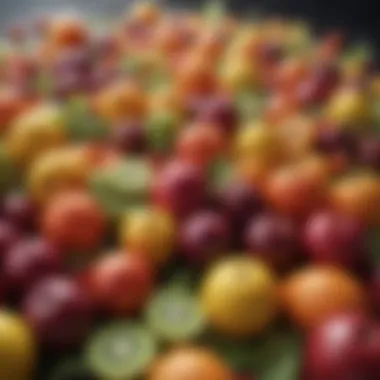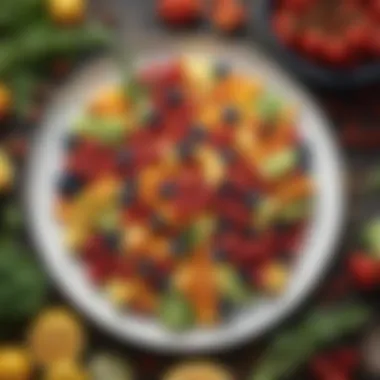Unveiling Quercetin: Natural Sources in Fruits & Veggies


Intro
Quercetin is a flavonoid polyphenol that has garnered significant attention for its health benefits. Found primarily in a variety of fruits and vegetables, this compound is linked to multiple positive health outcomes, including anti-inflammatory and antioxidant activities. As more individuals become aware of nutrition's role in well-being, it is essential to examine the natural sources of quercetin and how they can be incorporated into daily diets.
In this article, we will explore several fruits and vegetables that are rich in quercetin. We will also review their nutritional contributions and overall health implications. An understanding of these foods can guide health-conscious individuals toward better dietary choices.
Key Takeaways
- Quercetin is a powerful flavonoid with potential health benefits, such as reducing inflammation and combating oxidative stress.
- Certain fruits and vegetables are particularly high in quercetin, making them valuable additions to a balanced diet.
- Integrating these foods can assist in enhancing overall nutrition and health.
Summary of the main points discussed
- Quercetin's role in human health.
- Identification of quercetin-rich fruits and vegetables.
- Practical suggestions for incorporating these foods into diets.
Actionable insights for readers
- Begin including foods such as apples, onions, and kale in daily meals.
- Consider diversifying your intake of fruits and vegetables to increase quercetin levels.
In-Depth Analysis
Quercetin's potential benefits stem from its ability to function as an antioxidant. This means it helps neutralize free radicals in the body, which can otherwise lead to cellular damage and contribute to various diseases. Beyond its antioxidant properties, quercetin may also play a role in reducing inflammation, which is a common underlying factor in chronic diseases such as heart disease and diabetes.
Relevant scientific studies or evidence
Research indicates that diets high in flavonoids, including quercetin, are associated with lower rates of chronic illnesses. A study published in the Journal of Nutrition found that individuals consuming quercetin-rich foods showed reduced biomarkers of inflammation. Another significant piece of research highlighted quercetin's potential in enhancing exercise performance by reducing muscle fatigue.
Quercetin-Rich Fruits and Vegetables
The following fruits and vegetables are excellent sources of quercetin:
- Apples
- Onions
- Kale
- Broccoli
- Tomatoes
- Berries (such as blueberries and blackberries)
Including these foods in your diet can yield substantial health benefits. Salad preparations, smoothies, and stir-fry dishes offer excellent opportunities to enhance quercetin intake. Moreover, many of these options are not only nutritious but also versatile, allowing for creativity in meal planning.
“Incorporating quercetin-rich fruits and vegetables into your meals can bolster health and support a balanced diet.”
As we delve deeper into individual food sources, we will analyze their specific nutritional profiles and practical ways to integrate them effectively, ensuring that readers can maximize the benefits of quercetin in their daily nutrition.
Understanding Quercetin
Quercetin is a remarkable flavonoid that is increasingly recognized for its potential health benefits. This article aims to impart knowledge about quercetin, shedding light on its significance, particularly in the context of fruits and vegetables. In this section, we will explore what quercetin is, its vital role in human nutrition, and how it works within the body.
Definition of Quercetin
Quercetin is a type of plant pigment that falls under the category of flavonoids. It is predominantly found in various fruits, vegetables, and grains. The molecular structure of quercetin allows it to exhibit unique properties, making it a notable subject for research. It is often described as having strong antioxidant capabilities, helping to neutralize harmful free radicals in the body. Its presence in the human diet is substantial, influencing dietary choices and overall health.
Importance of Quercetin in Human Nutrition
Quercetin holds a prominent place in nutrition due to several reasons. Firstly, it is linked to numerous health benefits, which include anti-inflammatory and antioxidant effects. Incorporating quercetin-rich foods into daily meals may effectively contribute to improved health outcomes. Research suggests that diets high in flavonoids can support immune function and reduce the risk of chronic diseases. Additionally, quercetin may enhance the absorption of some essential nutrients, further aiding overall wellness.
Mechanisms of Action
Understanding how quercetin functions is crucial for recognizing its importance in nutrition. Quercetin interacts with various metabolic pathways in the body.


- Antioxidant Activity: It scavenges free radicals, reducing oxidative stress.
- Anti-Inflammatory Effects: It inhibits the release of certain inflammatory markers, contributing to lower inflammation levels.
- Vascular Benefits: Quercetin may promote cardiovascular health by improving blood flow and reducing blood pressure.
- Antihistamine Properties: It can block histamine release, which may help those with allergies.
"Quercetin plays a vital role in many physiological processes, enhancing well-being through its various beneficial effects."
Fruits Rich in Quercetin
Fruits rich in quercetin offer a fusion of flavor and health. As natural sources of this flavonoid, they can enhance dietary intake and promote wellbeing. Quercetin is well-known for its anti-inflammatory and antioxidant properties. Eating quercetin-rich fruits can contribute to reduced inflammation, improved heart health, and even enhanced immune function. The diverse array of available fruits presents an opportunity for health-conscious individuals to enrich their diets while enjoying a variety of tastes and textures.
Apples and Their Varieties
Apples are one of the most accessible sources of quercetin. Different varieties like Granny Smith, Red Delicious, and Gala offer varying levels of quercetin. Granny Smith apples are often recognized for their tartness, which usually translates to a higher quercetin content. They not only add crunch to salads but also offer a refreshing snack. Red Delicious apples are known for their sweet flavor and deep color. Their antioxidant profile, largely due to quercetin, makes them a popular choice. Each type of apple brings distinct tastes and seasonal availability, making them versatile in culinary uses.
Berries: A Powerhouse of Flavonoids
Berries are often touted for their high flavonoid content, specifically quercetin. The following varieties are noteworthy for their contributions.
Blackberries
Blackberries stand out with their dark color and rich flavor. They are not just delicious but also high in quercetin. Their abundance of antioxidants aids in combating oxidative stress. Eating blackberries can provide a sweet addition to smoothies, yogurt, or simply by themselves.
Blueberries
Blueberries are celebrated for their numerous health benefits, including their quercetin content. They are low in calories and high in fiber, making them a favored choice among health enthusiasts. Blueberries are often added to breakfast cereals or baked goods, thus enhancing nutrition without compromising taste.
Strawberries
Strawberries provide a refreshing taste and significant health benefits, including a good amount of quercetin. Their bright red color and sweet flavor make them delightful in desserts and salads alike. Besides, they are packed with vitamins that promote skin health and overall immunity.
Grapes and Quercetin Content
Grapes are another important source of quercetin. Specifically, red and black grapes have higher concentrations compared to green grapes. The skin of the grape contains notable amounts of this flavonoid, making it essential to consume them unpeeled for maximum benefit. Grapes also offer resveratrol, another beneficial compound, enhancing their overall appeal as a health booster. They can be enjoyed fresh, in salads, or as part of a refreshing juice.
Cherries as a Source of Quercetin
Cherries, particularly tart cherries, are recognized for their health benefits linked to quercetin. They exhibit anti-inflammatory properties and are often recommended for those suffering from chronic pain or joint issues. Their vibrant color and slightly sour taste contribute to various dishes, including pies and sauces. Incorporating cherries into the diet can be simple; they make a great snack or a sweet addition to smoothies.
Citrus Fruits: A Comparative Analysis
Citrus fruits also present varying degrees of quercetin content, with oranges and lemons being prime examples.
Oranges
Oranges are not only renowned for their vitamin C content but also provide a good amount of quercetin. Their sweetness makes them a popular fruit choice. Consuming oranges can help with hydration and nutrient intake, offering natural sugars and electrolytes, especially in warmer climates. They can be eaten raw or juiced for a refreshing drink.
Lemons
Lemons, with their tangy flavor, also contain quercetin. They can be used in various culinary applications, from dressings to drinks. While often thought of primarily for their vitamin C, the quercetin in lemons can enhance their health benefits. Lemons serve as an excellent addition to beverages, bringing flavor while also delivering antioxidants.
"Incorporating a variety of quercetin-rich fruits into your diet can offer numerous health benefits, from reducing inflammation to enhancing overall health."
Including these fruits as part of a daily diet can be straightforward and enjoyable. Utilizing seasonal fruits can also make consuming them more cost-effective while benefiting from their peak nutritional value.
Vegetables Containing Quercetin
The inclusion of vegetables in the diet is crucial for overall health. Various vegetables contain quercetin, which plays a significant role in offering the benefits associated with this flavonoid. Understanding the specific vegetables that are rich in quercetin can help individuals make informed nutritional choices. This section highlights the vegetables, detailing their contributions and unique advantages.


Onions: The Top Source
Red Onions
Red onions are particularly noted for their high quercetin content. This variety stands out due to its rich purple hue, which indicates a higher concentration of flavonoids compared to yellow or white onions. One key characteristic of red onions is their slightly sweet and sharp taste, making them popular in salads and garnishes. The unique feature of red onions lies in their ability to provide a potent dose of antioxidants. However, their strong flavor may not suit everyone's palate, which can be seen as a disadvantage for those who prefer milder tastes.
Yellow Onions
Yellow onions are another excellent source of quercetin. They are well-known for their versatile use in cooking, providing a balanced flavor that contributes well to various dishes. This type of onion contains a moderate amount of quercetin, and it is often available in most grocery stores. The key aspect of yellow onions is their culinary flexibility, recommending them for everyday cooking. Unlike red onions, they have a less intense flavor, making them a better choice for individuals who may have sensitivities to stronger onion varieties. Still, they might not offer as high a quercetin concentration as red onions, which is a factor to consider.
Leafy Greens and Their Benefits
Kale
Kale serves as a significant source of quercetin among leafy greens. It is often praised for its nutritional density, being rich in vitamins and minerals as well as quercetin. The important characteristic of kale is its dark green leaves, which signify high antioxidant levels. Additionally, this leafy green is very popular due to its health benefits, including its potential to improve heart health. However, individuals not accustomed to bitter flavors may find kale less appealing. Its tough texture might also require specific methods of preparation to enhance palatability.
Spinach
Spinach is another valuable leafy green rich in quercetin. Well-known for its versatility, spinach can be consumed raw in salads or cooked in various dishes. A key characteristic of spinach is its soft texture and mild flavor, making it more palatable for many compared to other greens. Spinach also offers an array of nutrients, complementing its quercetin content effectively. One potential downside is its oxalate content, which can interfere with calcium absorption. Thus, it is advisable for individuals with certain health concerns to moderate spinach consumption.
Tomatoes and Their Flavonoids
Tomatoes also deserve attention for their flavonoid content, including quercetin. These fruits, often treated as vegetables in culinary contexts, provide a vibrant addition to any diet. Tomatoes are extensive in various dishes like sauces and salads. Their unique feature includes the presence of lycopene alongside quercetin, contributing to their antioxidant profile. Nonetheless, some may experience acidity when consuming fresh tomatoes, so alternatives like cooked tomato products may benefit those with sensitive digestive systems.
Broccoli and Other Cruciferous Vegetables
Broccoli stands out as an important cruciferous vegetable containing quercetin. It is nutrient-rich and is suggested for its potential cancer-fighting properties. Being a versatile vegetable, broccoli can be prepared in numerous ways that retain its health benefits. Crucibles like broccoli also assist in detoxification processes in the body. However, overcooking broccoli can lead to a loss of nutrients, which should be noted when preparing it for meals.
Peppers: A Colorful Contribution
Bell Peppers
Bell peppers, available in multiple colors, present a diverse source of quercetin. Their crisp texture and sweet flavor make them a favorite addition to many dishes. One notable aspect of bell peppers is that they are also packed with vitamins A and C, enhancing their nutritional profile. However, bell peppers lack the heat found in their hotter counterparts, which might leave spice enthusiasts searching for more flavor excitement.
Hot Peppers
Hot peppers, including varieties like jalapeños and habaneros, also contribute to quercetin intake. Their unique heat and flavor can spice up a variety of dishes, appealing to many culinary preferences. Additionally, hot peppers are known for their capsaicin content, which adds potential health benefits. However, their spiciness may not be suitable for everyone, particularly individuals with digestive sensitivities.
Health Benefits of Quercetin
Quercetin has become increasingly highlighted for its robust health benefits. This flavonoid is noted for its role in promoting general well-being. Its contributions range from anti-inflammatory to antioxidant properties. These aspects not only enhance health but also influence disease risk. Understanding these benefits is critical for health professionals and wellness coaches. Addressing these elements can guide recommendations made to clients and patients.
Anti-Inflammatory Properties
Quercetin is widely recognized for its anti-inflammatory effects. It works by inhibiting the production of pro-inflammatory molecules. These molecules include cytokines and histamines, which play key roles in the inflammatory process. By reducing inflammation, quercetin can be beneficial for conditions like arthritis and asthma.
Moreover, studies suggest that regular consumption of quercetin-rich foods may improve responses to inflammation in the body. It helps in lessening the discomfort associated with chronic conditions. Including foods such as onions, apples, and citrus fruits into a diet can serve as a natural method to tap into these anti-inflammatory benefits.
Antioxidant Effects
The antioxidant properties of quercetin represent another essential aspect of its health benefits. Antioxidants protect cells from oxidative stress caused by free radicals. These free radicals are implicated in numerous health issues, including heart disease and certain cancers. Quercetin scavenges these free radicals, thus mitigating cellular damage.
Research indicates that foods high in quercetin can enhance the body’s defense against oxidative stress. This means a diet rich in fruits and vegetables can contribute significantly to long-term health. As health professionals, it is crucial to encourage clients to choose antioxidant-rich foods for overall wellness.


Potential Role in Disease Prevention
Quercetin’s potential role in disease prevention cannot be overlooked. Studies point to its protective effects against various conditions. For example, cardiovascular disease risk may be lowered by regular intake of quercetin-rich foods. Additionally, research mentions its potential link to lowering the incidence of certain cancers.
Some other promising areas of investigation include the potential of quercetin in managing blood sugar levels and enhancing immune function. These factors contribute to overall health and can lead to a decreased chance of chronic disease. Encouraging individuals to include quercetin sources in their diet could become an essential strategy in disease prevention programs.
"Incorporating quercetin-rich foods can have multifaceted benefits, enhancing both the quality of life and longevity."
In summary, the health benefits of quercetin play a significant role in nutrition and health discussions. Its anti-inflammatory and antioxidant effects, along with its potential in disease prevention, underscore the importance of quercetin-rich foods in a balanced diet. For those in health and wellness fields, understanding and promoting these benefits is a step toward better client health outcomes.
How to Incorporate Quercetin-Rich Foods into Your Diet
Quercetin is not only recognized for its benefits but also for its presence in various fruits and vegetables. Incorporating these sources into your diet is essential for enhancing your nutritional profile. It can be both simple and effective. This section will provide practical insights into how to include quercetin-rich foods in daily meals.
Practical Tips for Consumption
- Diversify Your Choices: Aim to include a variety of quercetin-rich fruits and vegetables in your diet. Each has unique flavors and nutrients. This variety can help you enjoy your meals more.
- Raw vs. Cooked: While cooking some vegetables can alter their nutrient content, many fruits are best enjoyed raw. Red onions, for example, are an excellent choice when consumed without cooking. Chopping them can also release more beneficial compounds, enhancing their health effects.
- Smoothies and Juices: Blend fruits like apples, berries, and grapes into smoothies. This method enhances the intake of quercetin while allowing for creativity in recipes. Consider using spinach or kale for added nutrition.
- Salads: Salads can be a great way to consume raw veggies. Combine leafy greens with slices of red onion, peppers, and a fruity dressing. This adds flavor and maximizes the quercetin content of your meal.
- Snack Smart: Use quercetin-rich fruits for snacking. Fresh cherries or citrus fruits can be easy and healthy choices. Consider keeping them handy for when cravings hit.
Meal Ideas Featuring Quercetin-Rich Ingredients
- Breakfast Options: Start your day with a smoothie bowl made from spinach, apple slices, and berries. Add some nuts for extra protein and texture.
- Lunch Ideas: Prepare a salad with arugula, sliced red onions, bell peppers, and a dressing made of lemon juice. This allows the quercetin to shine through.
- Dinner Delights: Include a side of roasted vegetables, such as broccoli and tomatoes. This not only provides quercetin but also makes for a colorful meal.
- Desserts: Try creating a fruit salad using cherries and berries. You can drizzle a bit of honey and sprinkle some mint for added flavor.
These simple yet effective ways can significantly boost quercetin intake in your daily meals. This helps to navigate the benefits of a diet rich in this flavonoid.
Considerations and Precautions
Understanding the considerations and precautions surrounding quercetin is crucial, especially for those integrating it into their diets. Quercetin, while beneficial, can interact with various medications and may lead to allergic reactions in some individuals. Recognizing these elements helps in making informed choices and minimizes potential health risks.
Potential Interactions with Medications
Quercetin may affect how certain medications work. It can inhibit enzymes in the liver that are responsible for drug metabolism. This interaction can lead to altered levels of medications in the bloodstream. For instance, common medications like blood thinners (warfarin) may see increased effects when combined with quercetin-rich diets.
Health professionals suggest that individuals on specific medications consult their healthcare provider before significantly increasing their quercetin intake.
Common Medications of Concern:
- Antihypertensives: Quercetin may enhance the effects, leading to lowered blood pressure.
- Anticoagulants: As mentioned, increased bleed risk is a concern.
- Certain antidepressants: There could be unwanted interactions affecting serotonin levels.
Allergic Reactions and Sensitivities
Although quercetin is considered safe for most, there are cases of allergic reactions. Individuals may have sensitivities to specific foods rich in quercetin. Common sources include onions, apples, and certain berries. Symptoms can vary from mild to severe.
Signs of Allergic Reactions:
- Skin Irritation: Rashes or hives may appear.
- Gastrointestinal Issues: Nausea, vomiting, or diarrhea can occur.
- Respiratory Symptoms: Some may experience difficulty breathing or nasal congestion.
Precautionary Measures:
- Introduce gradually: If trying a new quercetin-rich food, start with small portions.
- Monitor symptoms: Keep a diary of any adverse reactions.
Health professionals recommend paying attention to your body's responses when consuming these foods. If there are any signs of distress, cease consumption immediately and consult a healthcare provider.
Understanding the potential interactions and allergic reactions allows for safer dietary choices and maximizes the benefits of quercetin while minimizing risks.
Closure
In this article, we explored the myriad benefits of quercetin, emphasizing its role as a significant flavonoid found in various fruits and vegetables. Quercetin is notable not only for its antioxidant and anti-inflammatory properties but also for its potential effects on chronic disease management. For those concerned about their health, incorporating quercetin-rich foods into their diet presents a natural method for fortifying well-being.
Summarizing the Importance of Quercetin
It is essential to recognize that quercetin is more than just a nutrient; it is a compound with considerable implications for health. Recent studies suggest that regular consumption of foods high in quercetin may contribute to chronic disease prevention, particularly conditions such as cardiovascular diseases and certain types of cancer. Moreover, its anti-allergic properties can enhance overall quality of life for those with sensitivities. As a naturally occurring compound, quercetin provides an accessible means to harness the benefits of plant-based nutrition.







